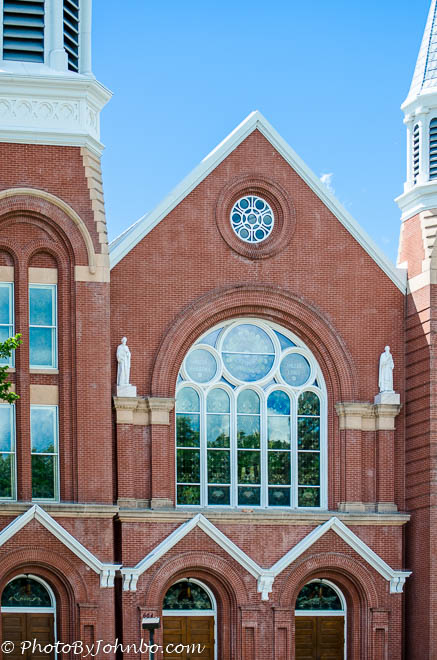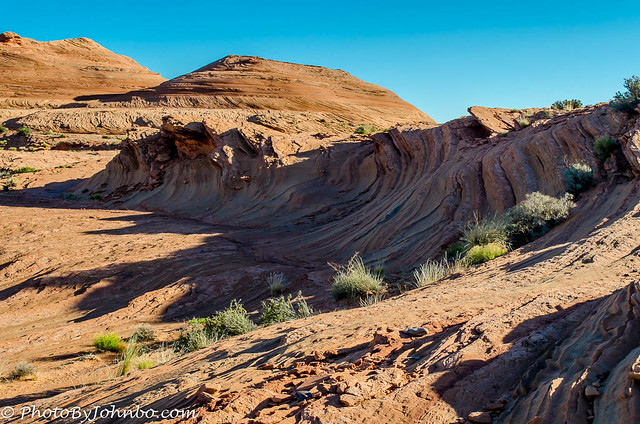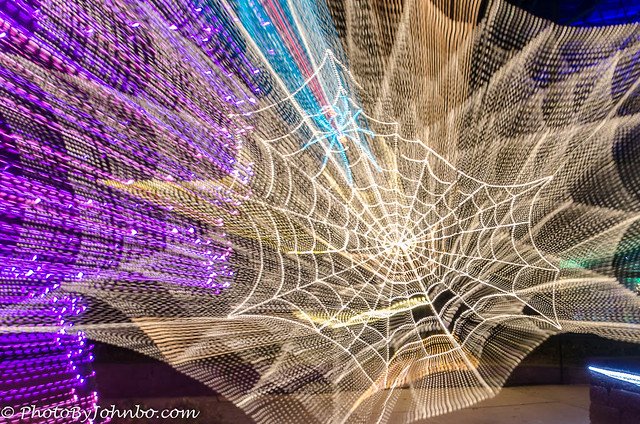
Of the many composition factors in photography, this challenge focuses on Shape, Form, Texture, and Light. Though your images probably use multiple techniques that often include several factors in basic composition, for this challenge, consider these four elements. Choose to highlight one or more of these aspects in your response, and present one or two of your favorites. You can decide to focus on only one aspect or include examples of all of them. And you can either choose from your existing collection or venture out for a challenge shoot. We’re eager to see your top picks that utilize any of these techniques.
Architects often use repeating basic shapes in design because the repetition is pleasing to the eye. Photographers often capitalize on the architects’ work by focusing the camera to maximize the repetition of shapes. Saint Mary’s Catholic Church in Fargo North Dakota is an example of an architect’s use of triangles, circles, rectangles, arches, and other basic shapes. In this composition, I focused on a major section above the entrance doors to the church.
On an excursion train in Georgetown, Colorado, we were on a siding waiting for the engine to be switched from one end of the train to the other. As the engine went by, I captured a shot of the engineer at work. This photo turned out to be one of my favorite compositions, mostly because there are several repeating rectangles in the image with the engineer being framed by the open window. Even the 111 painted on the engine represents nested rectangles.
The difference between shape and form can be muddy, but artists typically consider shape to be two-dimensional while a form is three-dimensional. An obvious comparison might be that a triangle is considered a shape and a pyramid is considered a form for the purpose of composition. In the photo above, the architect who designed the atrium of the Heritage Center in Bismarck, North Dakota used a 40-foot by 40-foot cube form as a design element. The nature of the cube is reinforced by the steel rectangular frames around the window panes in the glass and metal structure.
Artists and photographers also consider organic forms and landscape photographers work for years to master organic compositional techniques. Flowers are one of my favorite organic forms as subjects. Removing color from the photograph allows the viewer to focus on the form of this beautiful lily.
Adobe addresses texture in photography with this statement, “From moss-covered stones to prickly cactuses, texture images entice viewers, create moods, and communicate ideas…” In the desert near Page Arizona, the sandstone has been sculpted by wind and water for centuries. As I was hiking in the desert, I noticed the effects of wind as it molded the relatively soft rock into what can best be described as a wave. The wind took centuries to create in sandstone what it does in minutes to the water in the world’s oceans. There are many unique textures created by the elements in the composition, but the most interesting to me was the sandstone wave.
We enjoy visiting caves (if they aren’t too steep or strenuous). The Grand Cayman Island features a network of caves known as the Crystal Caves. There is also a Crystal Caves in Bermuda. That complex is still on my list of caves to visit. What I enjoy about caves is the myriad of textures found on the surfaces (which we are relentlessly reminded we cannot touch). The cave in the photo above is at ground level at one point and all of the textures in the walls and ceiling are easily visible in the sunlight streaming into the cave entrance.
Photos wouldn’t be possible without light and since the first cameras, capturing light is what photography is all about. We work with artificial light, await the perfect natural light, and are disappointed when the expected magical light doesn’t appear.
If you look up Compositional Tools on the Internet, you might not find a reference to light as a tool of composition. Yet light and shadow are used along with all of the other compositional tools to help us see the photographer’s vision. We position the camera and a light source to enhance the look of a portrait. We might even introduce equipment to create shadows in specific places to set a mood that would be entirely different if we did everything else exactly the same, but didn’t manipulate the light. We might position our camera in such a way as to create a backlight that might ultimately change the composition in its entirety.
Sometimes light is the main subject of our photos, especially at sunrise and sunset… but I am getting ahead of myself. Sometimes it’s fun to have the light as the main subject. In the display above, I captured a spider web of LED lights on display. To add an unusual effect to the image, I chose a longer shutter speed, pressed the shutter, waited for an instant, and then cranked the zoom lens all the way to the full zoom position. That momentary pause captured the bright LED design, and the zoom created light trails that expanded outward. It was a fun experiment.
Ah, those magical sunsets when the light is perfect, or nearly so. What better way to conclude this challenge? Oh, and did you notice the triangular shapes in this composition? The sails on the boat in the center and the mast and ropes on the other two boats form triangle shapes. Even the lighthouse and the terrain on the right form triangles.
You can check out HD versions of the images here via my Flickr site. Last week, Ritva challenged us to do some Window Shopping, a fun and interesting way to renew my hand at street photography and share a few favorites from my gallery. Next week, Ann-Christine will be our host for the Lens-Artists Challenge. Be sure to link to her page so you don’t miss the challenge post on Saturday. If you’d like to respond to our challenge each week and want to know how to get started, check here.
John Steiner







[…] into his stunning photos, and he graciously shares his tricks of the trade in his weekly posts, here. […]
A challenging challenge and one to learn from, John. I am always grateful for your wisdom in your view of the world. And I am always appreciative for the photography techniques you encourage us with. A wonderful post. thank you. I love all the shapes from the engineer photo. There is such a story to tell with that one photo made better by the composition. And you know I love, the textures in the sandstone hills near Page. My favorite must be the Caves. Cool place, I had never heard of. Thank you again for your inspiration. Well done!!!!
Thank you, Donna! I learned a lot in researching the terms and functions.
John, these are great images to illustrate the different techniques you chose for this challenge. I love the crystal Caves! Thanks for the challenge.
Thanks. I appreciate your compliment.
Great photos, great theme. Brick, geometric, organic, and crystal cave are among my many faves. Enlightening!
Thanks, John. Looking forward to seeing your response.
[…] For Lens Aritists Challenge––Photo Compotition: Shape, Form, Texture, Light […]
Yours are so majestic… Mine very different, but hope they meet the prompt: https://judydykstrabrown.com/2024/03/02/shape-form-texture-light-for-lens-artists-challenge/
I’m in love with the sunset image, John. Our Algarve cliffs provide great textures to play with too. The ‘spider’s web’ is too clever for me- I can only admire. Thanks for your helpful explanations.
Thank you, Jo!
Voila’: https://fairplay740.wordpress.com/2024/03/02/lens-artists-challenge-289-tools-of-photo-composition-lens/
And… https://fairplay740.wordpress.com/2024/03/02/lens-artists-challenge-289-tools-of-photo-composition-lens-pt-2/
[…] us with some key concepts. Please remember to link your response to John’s original challenge here, and to use the Lens-Artists Tag to help us find you. Thanks also to Ritva for last week’s […]
Wonderful post and theme. You have some beautiful images here but surprisingly enough, given my penchant for landscapes, I find the image of the engineer enthralling.
Excellent challenge John and I absolutely love the image “Capturing Light” that one is outstanding even surrounded by the other terrific captures. Another favorite was your geometric form – that’s really a fun find! This one will be interesting to watch as our followers work to find examples.
This is a great and educational challenge John. I don’t know about others, but I just compose a photo the way I like would like it to be seen. You’ve given me a path to travel down and a lot to think about!
[…] really don’t pay much attention to the rules and tools of composition. I do believe I needed John’s challenge today. He has me thinking of how and why I do things regarding composing a […]
[…] lens-artists photo challenge […]
hello john,
a great and interesting theme i really like your pictures especially the 3rd, 4th and last one.
here is my contribution to the challenge https://wp.me/pfnz9O-aS.
best regards robert
Thanks, Robert! I appreciate the compliments!
[…] [The Lens Artists Challenge is hosted this week by Johnbo.] […]
[…] [The Lens Artists Challenge is hosted this week by Johnbo.] […]
[…] to Lens-Artists: Of the many composition factors in photography, this challenge focuses on Shape, Form, Texture, […]
[…] John brings us the Lens-Artist Challenge this week. […]
I really like the atrium of the Heritage Center in Bismarck, the photo is awesome.
My contribution is here: https://deoculomeo.wordpress.com/2024/03/02/jerusalem-baptist-church/
Thank you! It’s a beautiful building.
Wow you have certainly set us a great challenge John. You have some great photos too. They have got me thinking, and if I’m honest searching.
I’m looking forward to your response. I know it will be stunning as usual.
That’s a lot of pressure, you might be disappointed.
I doubt that! 🙂
John, at first I thought I would not be able to tackle this challenge successfully. After going through a few dozen images in different locations, I settled on one place to cover the challenge. This was a fantastic challenge. Here’s my link:
https://egidio.photography/shape-form-texture-and-light-in-photography/
Thanks, Egidio. I am glad to get positive feedback. I hope everyone had fun looking for examples.
The comment in your post about seeing these elements in many images is an excellent point. It seems they automatically draw the photographer’s attention to the subject.
[…] us with some key concepts. Please remember to link your response to John’s original challenge here, and to use the Lens-Artists Tag to help us find you. Thanks also to Ritva for last week’s […]
[…] Posted for John’s Lens-Artists Challenge […]
Excellent challenge, John. One that had me thinking how to approach it. Your post was great in helping out, thank you. Love all your photos, especially the light one, I have to give it a go myself, it looks awesome.
Here is mine:
Thanks, Sofia. Nice work on your challenge response!
[…] this week is about. I really had to concentrate on this one, not the easiest to tackle. Thank you John for providing great samples to get me […]
[…] This is my submission into the two hundred-and-eighty-ninth Lens-Artists Photo Challenge. The theme for this one is “Tools of Photo Composition“. […]
Nice photos, and some words to think about too. Easy and straightforward stuff, I think.
Here’s mine for this one:
[…] This week Johnbo challenges us to focus on Tools of Photo Composition. […]
Such great images to illustrate the challenge. Really love the web lights… and everything else.
Here is mine for this week: https://wanderingteresa.com/venice-at-night/
[…] host this week is John from Journeys with johnbo, and if you want to read more about the challenge please check out his […]
[…] LensArtists Photo Challenge #289: tools of composition […]
[…] The theme for the weekly Lens-Artists Photo Challenge #289 is ‘tools of photo composition’. Waiting for a train, enjoying the sun. […]
[…] was just the impetus I needed to get the brain into a creative mode. This recent outing along with John’s photo challenge prompt sent the creative juices flowing, and me scouring my computer for photographs that might fit […]
[…] Johnbo – is taking the reins of Lens-Artists Photo Challenge and he’s talking about tools of photo composition, specifically, he’s focusing on shape, form, texture, and […]
Thank you for the interesting challenge, John, well done. I agree that your composition in the engineer at work photo captures all of the tools you gave us to use in the challenge. Your nature shots are stunning. The spider web photo is SO cool – I’m glad you explained as to how you captured it. Fascinating! Thank you for hosting this week.
Thank you, Shelley, for taking the time to comment!
You’re welcome, thank you again for hosting this week!
[…] Lens-Artists Weekly Photo Challenge #289: Tools of Photo Composition […]
Beautiful photographs John and such an interesting challenge! My contribution for this week is here: https://tranature.com/2024/03/03/silent-sunday-composed-by-light-and-wind/
Thanks
Thanks John. Anita
[…] Journeys with Johnbo’s lens-artists challenge invites photographers to see the compositions of shape, form, texture, and light […]
And interesting challenge John and some fantastic images too.
You did a beautiful job demonstrating the tools of composition, John. Of course, I love all that Northern AZ wavy sandstone. I’m drawn to natural landscapes and organic forms, but the angles in the train’s geometric images and the Heritage Center’s atrium are truly wonderful. I will join you on Wednesday with my entry!
Thanks, Terri. Looking forward to it!
[…] publication, except the one by Yokomizo, which was set in the late 1940s. The books follow the forms of classic criminal mystery stories. They are either locked room mysteries or, as in three of them, […]
[…] John’s Lens-Artists Challenge #289 – Tools of Photo Composition. See John’s excellent discussion of the use of shape, form, texture, and light in […]
Interesting challenge with some lovely photos. I liked your photo of a geological wave specially. But not only that. The steam engine was another favourite, and I liked that transparent cube too.
This week I have https://anotherglobaleater.wordpress.com/2024/03/04/the-old-and-new-orthodoxies/
Thanks, I. J.!
[…] Lens-Artists Challenge #289 […]
[…] John is inspiring us this week with a terrific challenge. He asks us to focus on 4 compositional tools, which can help us create images with greater visual appeal. His post is insightful and informative, so be sure to take a look at Journeys with Johnbo. […]
[…] Artist Photo Challenge is to focus on shape, form, texture, and light as tools of composition. The lead post by Johnbo explains it well and has many fine […]
[…] The theme for the weekly Lens-Artists Photo Challenge #289 is ‘tools of photo composition’. Light, form and shapes when they appear not to be there. […]